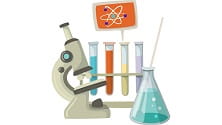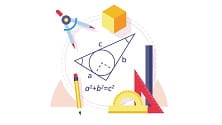Ever wondered why air conditioners are placed high, and radiators near the ground? Why is a warm beverage the best thing on a cold day? How can we detect people in the dark? Answer to all that is the same – Heat transfer! And what makes something good heat conductor? Let’s explore all that in this fun kitchen experiment.
Article Contents
1. What is Heat conduction?1.1. More in-depth heat conduction explanation
1.2. Convection and Radiation – other forms of Heat transfer
2. Thermal conductivity and thermal resistivity
3. Materials needed for Heat conduction experiment
4. Instructions for Heat conduction experiment
5. Silver Coin Experiment idea
6. What will you develop and learn
What is Heat conduction?
In simplest terms, heat conduction is the movement of warmth (heat) from one object to another. So, when we have two objects with different temperatures and they come into contact, we can observe heat or thermal conduction.
Imagine you come from the outside in the winter and your hands are freezing. You take the warm cup of tea and you just hold that cup for a few minutes. You can feel the warmth coming back into your freezing hands. That’s an example of the heat conduction! When we touch the hot cup, the heat flows from the hotter object (cup) to the colder one (our hands). Thermal conduction also happened when we poured hot water into the cup with room temperature.
The knowledge about thermal conductivity led to some fascinating products that we use in everyday life. Examples include thermal bottle or cookware that is designed to prevent temperature change. Heat conduction is surely making our lives much more convenient, so let’s learn more about it.
More in-depth heat conduction explanation
You probably know that all things are made of atoms – tiny, microscopic particles that form all matter. Atom is a neutral particle that has a positively charged nucleus at its center and negatively charged electrons moving around the nucleus.
The temperature of the object is actually a measure of how fast its atoms are moving. And the heat is a measure of the total energy created by vibrations of atoms.
Thermal conduction happens when we raise the temperature of an object. With that, we also increase its kinetic energy. That means that atoms inside it start to move faster and that naturally increases the chance of them bumping into each other. How much will they collide also depends on the density of a material we have on our hands. When atoms are more tightly packed, they will naturally collide more often. That’s why metals (which are very dense) are much better heat conductors than say wood.
Moving atoms hit neighborhood atoms and pass the energy to them. And that is the heat conduction in a nutshell.
Convection and Radiation – other forms of Heat transfer
While cooking a meal, did you ever notice how food inside the pot is moving up and down in the water? You probably did, but did you ever wonder why is it so? The answer is convection – another form of heat transfer. Ther raising smoke above the water is also another example of convection and it represents the movement of the heated air.
In other words, convection is the process of heat transfer by the movement of fluids and gases. Convection cannot occur in solids because particles of solids are fixed and close to each other. Remember, with solids, we are talking about conduction and vibrations of particles.
When convection occurs, particles of fluids and gasses near the heat source become hotter and thus their density decreases. With lower density, they are rising and colder particles take their place near the heat source and the process repeats.
That’s why heaters are usually placed near the ground. That makes hot air raise and sets up a convection current that circulates in the room and warms it. And that is the reason why air conditioners are near the ceiling. Hotter air raises up to be cooled and the cool air moves down. Natural phenomena like wind can also be produced by convection. Convection current (wind) is created due to the difference in temperature above the sea and the land.
And what about the life-giving heat from the Sun? Space between the Sun and the Earth is a vacuum, and conduction and convection need matter as a medium to transfer the heat. That’s where the third heat transfer process comes into play – radiation.
Radiation is the process of heat transfer by electromagnetic waves. Electromagnetic waves are oscillatory magnetic and electric fields that can easily travel in a vacuum. The sun emits many different kinds of electromagnetic radiation. The light we get from the sun is one example of electromagnetic radiation. The energy that comes from the sun (by energy, we mean heat) is also electromagnetic radiation.
Even human bodies radiate energy. Our bodies are warm and they radiate infrared radiation. That’s why we can use infrared cameras to locate the living organisms even in dark (remember Predator from the movie?).
Thermal conductivity and thermal resistivity
In the simplest form thermal conductivity is the characteristic of a material that describes how fast can heat pass through that material. So, it is the ability to conduct heat. The thermal conductivity of a material is the most important factor in the development of new technologies for heating and cooling.
Most metals and gasses are blessed with great heat conduction properties. Why? It’s all down to the atomic structure of the element, or more accurately their electron configuration. Metals usually have some free moving electrons inside of their atoms (they are called valence electrons). When we provide an electrical charge to those atoms, their electrons start to move and jump from one atom to another. That’s how electricity travels through the metal. Good electricity conductors are also good heat conductors.
Some of the more popular thermal conductors are Copper, Aluminium, Silver, and Gold.
Opposite to thermal conductivity, we have a thermal resistivity. Materials with high thermal resistivity don’t conduct heat well and are slow to pass heat or to cool down. We call them insulators. Unlike metals, they do not let electrons easily move from one atom to another. These electrons are tightly bound and therefore don’t pass electricity (or heat) to neighboring atoms.
Some common insulator materials are glass, plastic, rubber, air, and wood. Thermal insulators are widely used in home insulation, clothing, and cars to keep the warmth. We can also find them in freezers, refrigerators, and thermoses to keep things cold.
Materials needed for Heat conduction experiment

- Empty bowl
- Boiling water
- Butter
- Spoons (or sticks) of various materials – we used plastic, wooden and metal
Instructions for Heat conduction experiment
We have a video on how to make heat conduction experiment at the start of the article or continue reading instructions below if you prefer step by step text guide.
- Put a piece of butter on the tip of each spoon (wooden, plastic and metal).
- Place the spoons in the bowl so that part with butter is on the top.
- Pour boiling water in the bowl over the spoons. Leave part with the butter outside of the water.
- Observe! Will the butter melt? Which one is melting first? Do you know why? What can we conclude about the conductivity of used materials?
Silver Coin Experiment idea
Silver is one of the best heat conductive metal and if you have a silver coin nearby, you can try another simple and easy heat conduction experiment.
Put a silver coin on the ice cube and it should pass through the cube almost like it is made from the thick syrup. This is because silver is so good at thermal conduction it draws heat from the air and transfers that heat to the ice cube. And ice cube, naturally, starts to melt.
What will you develop and learn
- What is conductivity
- Different methods of heat transfer – conduction, convection, and radiation
- What makes something a conductor or an insulator
- That science is fun! 🙂
If you liked this activity and are interested in more physics experiments, we recommend exploring the force of pressure in Can crash experiment. Or take a look at density with our simple Orange density experiment. For more applied science, you can check out some of the classics: Rocket on vinegar and baking soda propulsion or a Lava lamp.
If you’re searching for some great STEM Activities for Kids and Child development tips, you’re in the right place! Check the Categories below to find the right activity for you.

STEM Science
Videos, guides and explanations about STEM Science in a step-by-step way with materials you probably already have at your home. Find new Science ideas.
Read more
STEM Technology
Videos, guides and explanations about STEM Technology in a step-by-step way with materials you probably already have at your home. Find new Technology ideas.
Read more
STEM Engineering
Videos, guides and explanations about STEM Engineering in a step-by-step way with materials you probably already have at your home. New Engineering ideas!
Read more
STEM Math
Videos, guides and explanations about STEM Math in a step-by-step way with materials you probably already have at your home. Find new Mathematics ideas.
Read more
Psychology
Find out all about development psychology topics that you always wanted to know. Here are articles from child psychology and development psychology overall.
Read more
First year of Child’s Life
Following a Child’s development every month from its birth. Personal experiences and tips on how to cope with challenges that you will face in parenting.
Read more


5 thoughts on “What is Heat Conduction and how to demonstrate it”